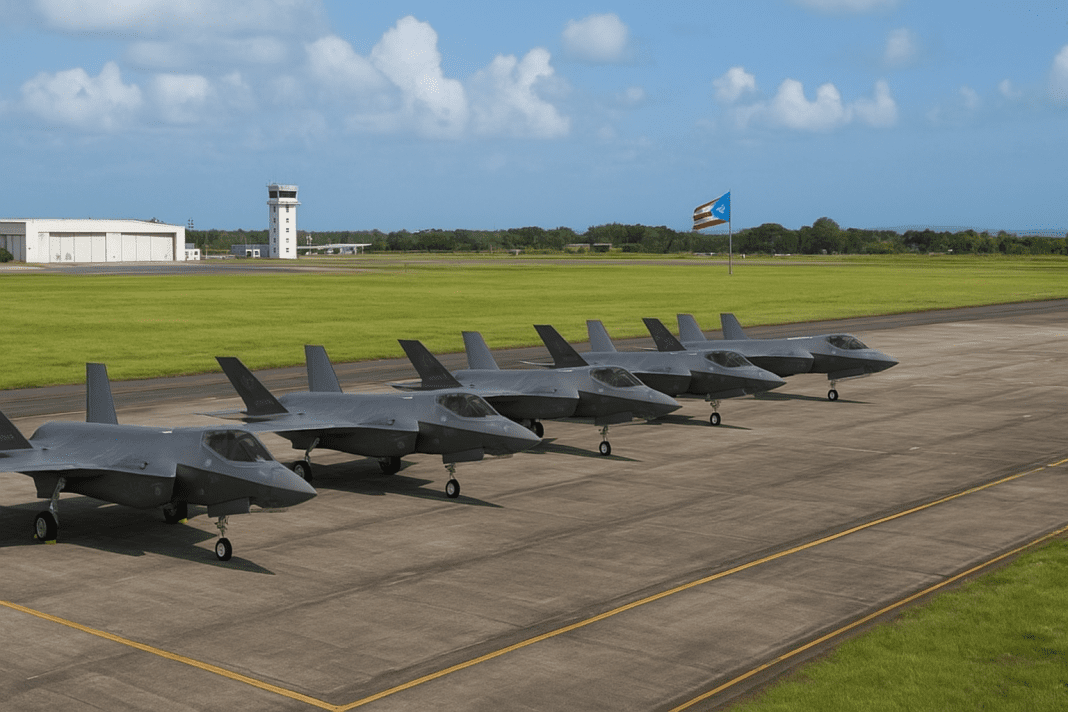The United States has deployed ten F-35 fighter jets to Puerto Rico, marking a new stage in its growing military presence across the Caribbean. While several Navy ships have already been sent to the region in recent weeks, this is the first time advanced land-based strike aircraft are being stationed there for operations.
F-35s Stationed in Puerto Rico
The F-35s will join ongoing missions designed to support naval forces already patrolling the area. They are expected to operate from Puerto Rico’s largest air base, located in San Juan. This airfield is home to the island’s Air National Guard and has long been a hub for both local and U.S. military aircraft. Officials have not confirmed which branch of the armed forces the jets belong to or their home base of origin.
The decision comes at a time of heightened tension in the southern Caribbean. The jets will serve alongside naval vessels already in the area, which include guided-missile destroyers, a missile cruiser, an attack submarine, and a Marine amphibious ready group. The arrival of the F-35s marks a visible show of air power that had so far been absent in the current buildup.
War drums in the Caribbean: armed Venezuelan F-16 jets fly directly over U.S. Navy warship
Naval Presence and Puerto Rico’s Role
The movement of these aircraft follows several weeks of naval deployments. At least eight U.S. warships are now stationed in the region. Among them are three Aegis-class destroyers and a Ticonderoga-class guided-missile cruiser. A fast-attack submarine has also joined the deployment, adding underwater capabilities to the surface fleet.
In addition, a Marine amphibious group with thousands of personnel and landing ships is present in the Caribbean. This group is equipped for a wide range of missions, from sea operations to land-based tasks. Together, these ships and aircraft represent one of the most visible buildups in the region in years.
178 global probes link Panama companies to Venezuelan corruption schemes worth billions
Puerto Rico has become the central point for air operations. By hosting the F-35 jets, the island is now serving as a strategic location for coordinating missions with naval forces. The presence of stealth fighter jets in Puerto Rico highlights its importance in the wider campaign against drug trafficking routes across the Caribbean.
Earlier in the week, U.S. aircraft carried out a strike against a vessel in the Caribbean Sea. The strike destroyed the boat, which officials identified as being part of a trafficking operation. Reports confirmed that 11 people on board were killed. Authorities have said the vessel was linked to a criminal organization and was transporting narcotics, though no detailed evidence has been publicly released.
Regional Tensions Around Puerto Rico
The deployment of F-35 jets to Puerto Rico comes against the backdrop of rising regional tensions. In recent days, military aircraft from a neighboring country flew close to a U.S. Navy destroyer operating in the Caribbean. In response, both sides carried out additional patrols and surveillance activities.
Meanwhile, several governments in the region mobilized their own forces. They positioned troops near border areas and deployed naval units and drones along coastlines. Officials explained these steps as part of anti-drug trafficking measures.
Puerto Rico now sits at the center of this regional standoff. The island hosts advanced fighter jets and serves as a launch point for operations, giving it a major role in U.S. military strategy. The combination of air power from Puerto Rico and naval assets at sea creates a significant concentration of force in the Caribbean.
The U.S. military treats traffickers in the region as serious threats. Officials call them “narcoterrorists” and emphasize that drug networks face the same targeting as global terror groups. Presidential war powers and earlier authorizations outline the legal justification for these actions.
Despite these explanations, observers have noted that the tactics go beyond traditional Coast Guard interdictions. Normally, forces intercept and search drug boats. Instead, they now use advanced fighter jets and naval vessels, expanding the scope of operations. Instead, in this case, the use of advanced fighter jets and naval vessels shows an expansion of operations.
As of now, Puerto Rico holds a prominent role in this buildup. The deployment of F-35 jets to Puerto Rico adds a new layer of air power to naval forces, creating one of the most extensive military concentrations in the region in recent years.

